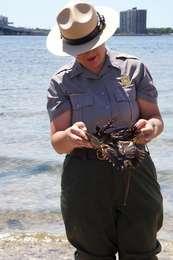Last updated: February 12, 2021
Place
Horseshoe Crabs

Throughout spring, the beaches around Jamaica Bay are host to a curious, ancient creature. Horseshoe crabs have wandered the earth for more than 450 million years, 200 million years longer than the dinosaurs. These living fossils play an incredibly important role in the ecological food web, their eggs and larvae a vital food source for migrating shorebirds. The Red Knot, a robin-sized shorebird that travels 9,000 miles each way on its annual migration from the tip of South America to the Canadian Arctic, is one shorebird that fuels up each year on the tiny green horseshoe crab eggs found along these shores. Although horseshoe crabs have survived many mass extinction events in their long history, they face their most serious threat today in the forms of overharvesting and habitat loss.
